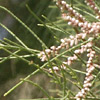The branches of Tamarix aphylla erect type are upright and form an acute angle with the trunk, thus it forms an erect canopy which may, under good conditions, reach an old age and a height of 15 m. The bark of the tree is brown and has deep grooves. The leaves are tiny scales that encircle the top of each node on the fine twigs. The green twigs appear to be divided into small internodes and are less branched and longer than those of the regular Tamarix aphylla.
Tamarix aphylla erect type blooms in the end of August and in September, with a less plentiful and concentrated inflorescence. The flowers are tiny, and are arranged, as in other Tamarix species, in dense spikes at the tips of the branches. The flower has 5 small sepals and 5 white petals. There are 5 stamens, and 3 stigmata at the head of the pistil. The fresh seeds germinate easily when they fall on wet soil, but if they do not reach a suitable place they lose their viability within a few weeks.
The mature plant has several traits that indicate adaptation to dry conditions: the thin branches contain the chlorophyll and carry out photosynthesis. The stomata are sunken within grooves along the internodes, and are thus protected from excessive water loss. Furthermore, the Tamarix aphylla, similarly to other plants of the Tamaricaceae family, such as the Reaumuria, has special glands for excretion of salt to the surface of the small green branches. These glands concentrate salts that have reached the shoot together with the water that was absorbed from the soil, and excrete them as a very concentrated basic solution. During the day the solution dries, and dry salt precipitate accumulate on the leaves. In this manner the tree gets rid of the toxic salts, which could have accumulated in the cells and harmed their viability. In areas where the water is salty, table salt (sodium chloride) comprises the main salt excreted. The salt that accumulates on the branches absorbs water during the humid nights and the resulting concentrated salt solution drips to the ground under the tree. The soil beneath the crown thus has an upper layer that is rich in salt, and most competing plants cannot germinate in it. Like the common Tamarix aphylla, in the absence of sodium salt it excretes a calcium solution. Since this solution is very basic, it absorbs carbon dioxide from the air and creates a layer of lime on the branches. This lime is not easily washed off, and it imparts the branches a light color.
Propagation of this species is by cuttings only. It was imported to Israel from Cyprus, but its original origin is unknown, it is planted in wind breakers in the Southern Aravah and in groves in other parts of the country.
Written by Amram Eshel






